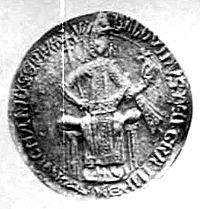Latin_emperor
Latin Emperor
Ruler of the Latin Empire (1204–61)
The Latin Emperor was the ruler of the Latin Empire, the historiographical convention for the Crusader realm, established in Constantinople after the Fourth Crusade (1204) and lasting until the city was recovered by the Byzantine Greeks in 1261. Its name derives from its Catholic and Western European ("Latin") nature. The empire, whose official name was Imperium Romaniae (Latin: "Empire of Romania"), claimed the direct heritage of the Eastern Roman Empire, which had most of its lands taken and partitioned by the crusaders. This claim however was disputed by the Byzantine Greek successor states, the Empire of Nicaea, the Empire of Trebizond and the Despotate of Epirus. Out of these three, the Nicaeans succeeded in displacing the Latin emperors in 1261 and restored the Byzantine Empire.
This article needs additional citations for verification. (September 2014) |







